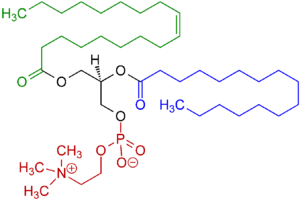Earth:Biosurfactant
Biosurfactant usually refers to surfactants of microbial origin.[1] Most of the biosurfactants produced by microbes are synthesized extracellularly and many microbes are known to produce biosurfactants in large relative quantities.[2] Some are of commercial interest.[3] As a secondary metabolite of microorganisms, biosurfactants can be processed by the cultivation of biosurfactant producing microorganisms in the stationary phase on many sorts of low-priced substrates like biochar, plant oils, carbohydrates, wastes, etc. High-level production of biosurfactants can be controlled by regulation of environmental factors and growth circumstances. [4]
Classification
Biosurfactants are usually categorized by their molecular structure. Like synthetic surfactants, they are composed of a hydrophilic moiety made up of amino acids, peptides, (poly)saccharides, or sugar alcohols and a hydrophobic moiety consisting of fatty acids. Correspondingly, the significant classes of biosurfactants include glycolipids, lipopeptides and lipoproteins, and polymeric surfactants as well as particulate surfactants.[5]
Examples

Common biosurfactants include:
- Bile salts are mixtures of micelle-forming compounds that encapsulate food, enabling absorption through the small intestine.[6]
- Lecithin, which can be obtained either from soybean or from egg yolk, is a common food ingredient.
- Rhamnolipids, which can be produced by some species of Pseudomonas, e.g., Pseudomonas aeruginosa.[7]
- Sophorolipids are produced by various nonpathogenic yeasts.
- Emulsan produced by Acinetobacter calcoaceticus.[3]
Microbial biosurfactants are obtained by including immiscible liquids in the growth medium.[8]
Applications
Potential applications include herbicides and pesticides formulations, detergents, healthcare and cosmetics, pulp and paper, coal, textiles, ceramic processing and food industries, uranium ore-processing, and mechanical dewatering of peat.[8][1][2]
Oil spill remediation
Biosurfactants enhance the emulsification of hydrocarbons, thus they have the potential to solubilise hydrocarbon contaminants and increase their availability for microbial degradation.[9][10] In addition, biosurfactants can modify the cell surface of bacteria that biodegrade hydrocarbons, which can also increase the biodegradability of these pollutants to cells.[11] These compounds can also be used in enhanced oil recovery and may be considered for other potential applications in environmental protection.[12]
References
- ↑ 1.0 1.1 Mulligan, Catherine N. (2005). "Environmental applications for biosurfactants". Environmental Pollution 133 (2): 183–198. doi:10.1016/j.envpol.2004.06.009. PMID 15519450.
- ↑ 2.0 2.1 Ron, Eliora Z.; Rosenberg, Eugene (2001). "Natural roles of biosurfactants. Minireview". Environmental Microbiology 3 (4): 229–236. doi:10.1046/j.1462-2920.2001.00190.x. PMID 11359508.
- ↑ 3.0 3.1 Gutnick, D. L.; Bach, H. (2000). "Engineering bacterial biopolymers for the biosorption of heavy metals; new products and novel formulations". Applied Microbiology and Biotechnology 54 (4): 451–460. doi:10.1007/s002530000438. PMID 11092618.
- ↑ "Biosurfactant, a green and effective solution for bioremediation of petroleum hydrocarbons in the aquatic environment". Discover Water 2 (1): 5. April 2022. doi:10.1007/s43832-022-00013-x. Bibcode: 2022DiWat...2....5Z.
- ↑ "Microbial production of surfactants and their commercial potential" (in en). Microbiology and Molecular Biology Reviews 61 (1): 47–64. 1997. doi:10.1128/mmbr.61.1.47-64.1997. ISSN 1092-2172. PMID 9106364.
- ↑ Bhagavan, N.V.; Ha, Chung-Eun (2015). "Gastrointestinal Digestion and Absorption". Essentials of Medical Biochemistry. pp. 137–164. doi:10.1016/B978-0-12-416687-5.00011-7. ISBN 9780124166875.
- ↑ Oliveira, F. J. S.; Vazquez, L.; de Campos, N. P.; de França, F. P., Production of rhamnolipids by a Pseudomonas alcaligenes strain. Process Biochemistry 2009, 44 (4), 383-389
- ↑ 8.0 8.1 Desai, Jitendra D.; Banat, Ibrahim M. (1997). "Microbial production of surfactants and their commercial potential". Microbiology and Molecular Biology Reviews 61 (1): 47–64. doi:10.1128/mmbr.61.1.47-64.1997. PMID 9106364.
- ↑ "High- and low-molecular-mass microbial surfactants". Appl. Microbiol. Biotechnol. 52 (2): 154–162. August 1999. doi:10.1007/s002530051502. PMID 10499255.
- ↑ "Influence of oil contamination levels on hydrocarbon biodegradation in sandy sediment". Environ. Pollut. 112 (3): 515–519. 2001. doi:10.1016/S0269-7491(00)00128-7. PMID 11291458.
- ↑ Kaczorek, Ewa; Pacholak, Amanda; Zdarta, Agata; Smułek, Wojciech (2018-08-26). "The Impact of Biosurfactants on Microbial Cell Properties Leading to Hydrocarbon Bioavailability Increase" (in en). Colloids and Interfaces 2 (3): 35. doi:10.3390/colloids2030035. ISSN 2504-5377.
- ↑ "Biosurfactant enhanced remediation of oil-contaminated environments". Adsorpt. Sci. Technol. 18 (2): 171–176. 1999. doi:10.1260/0263617001493369.
External links
 |

